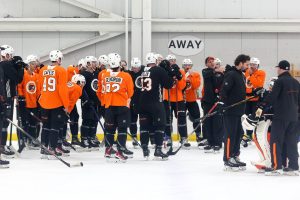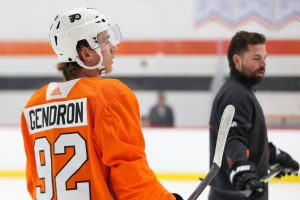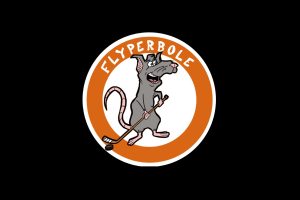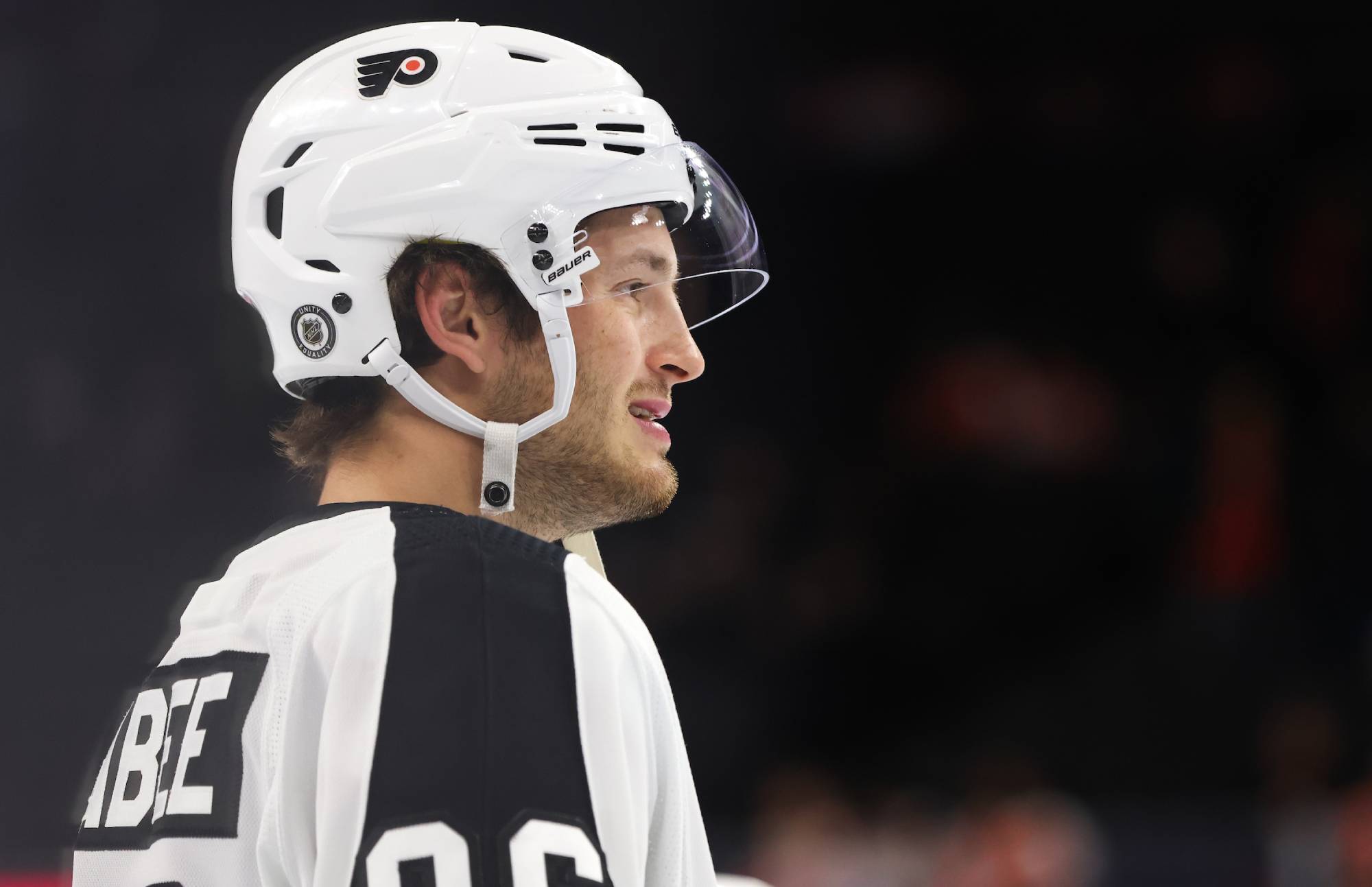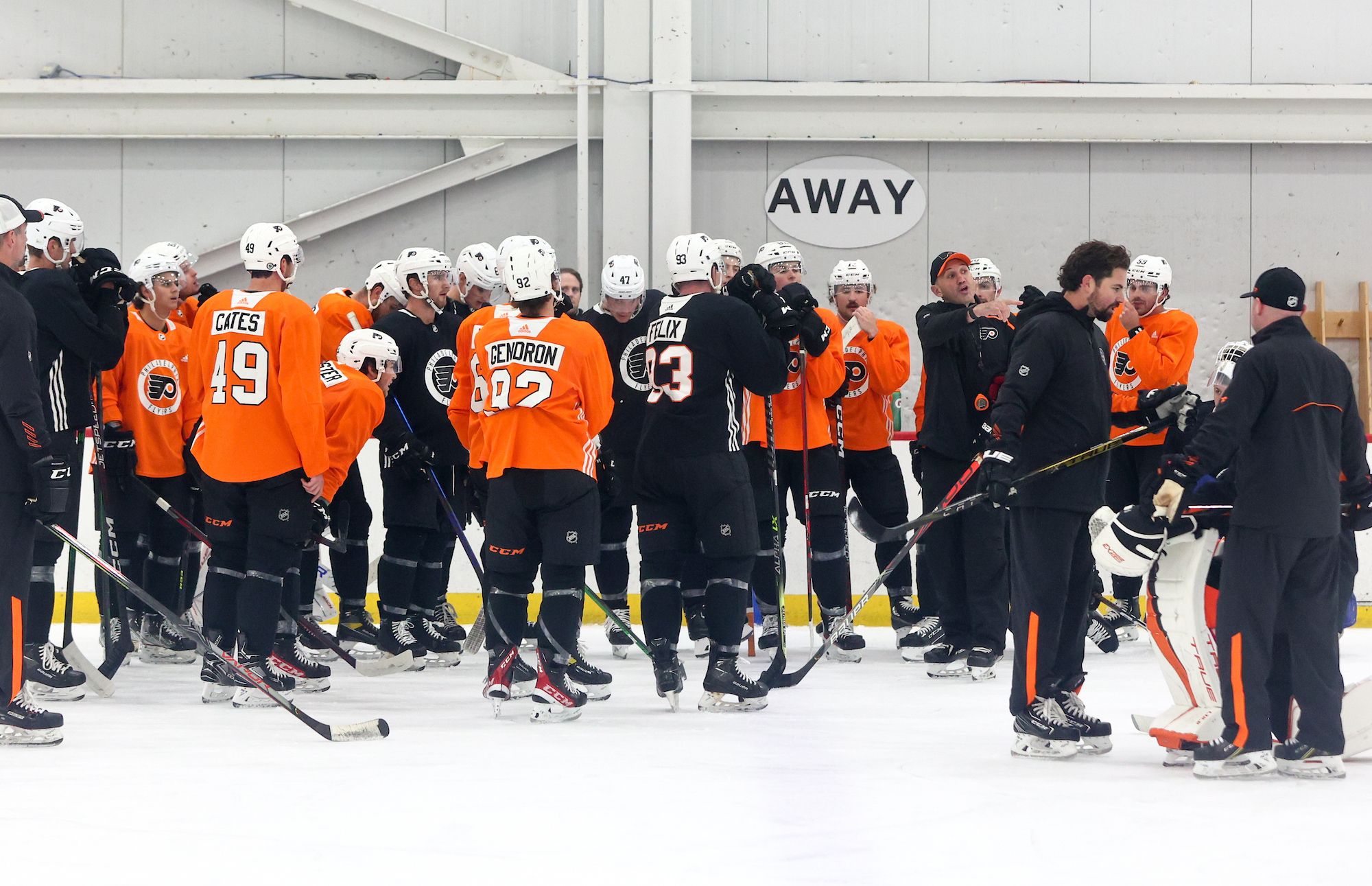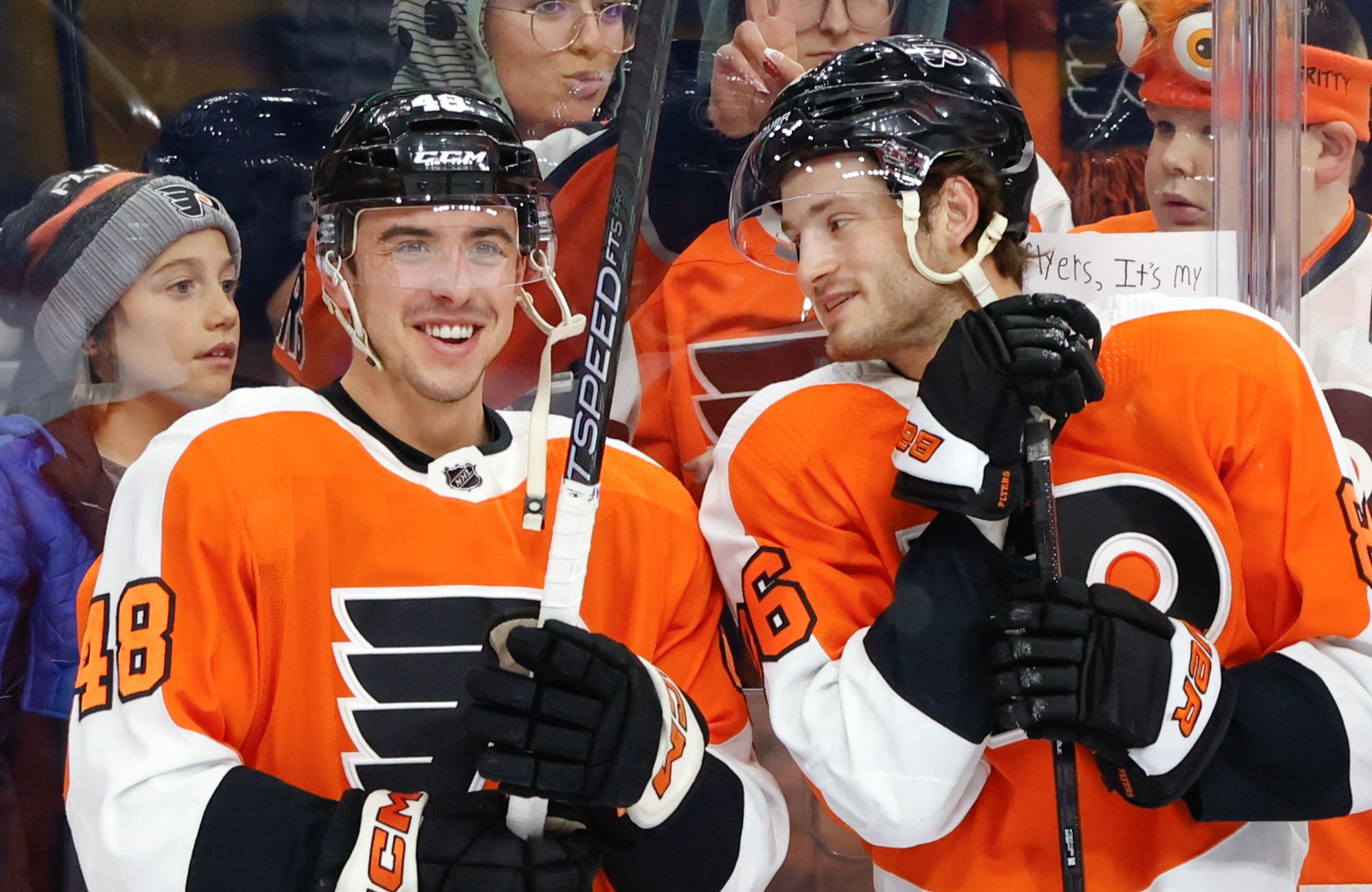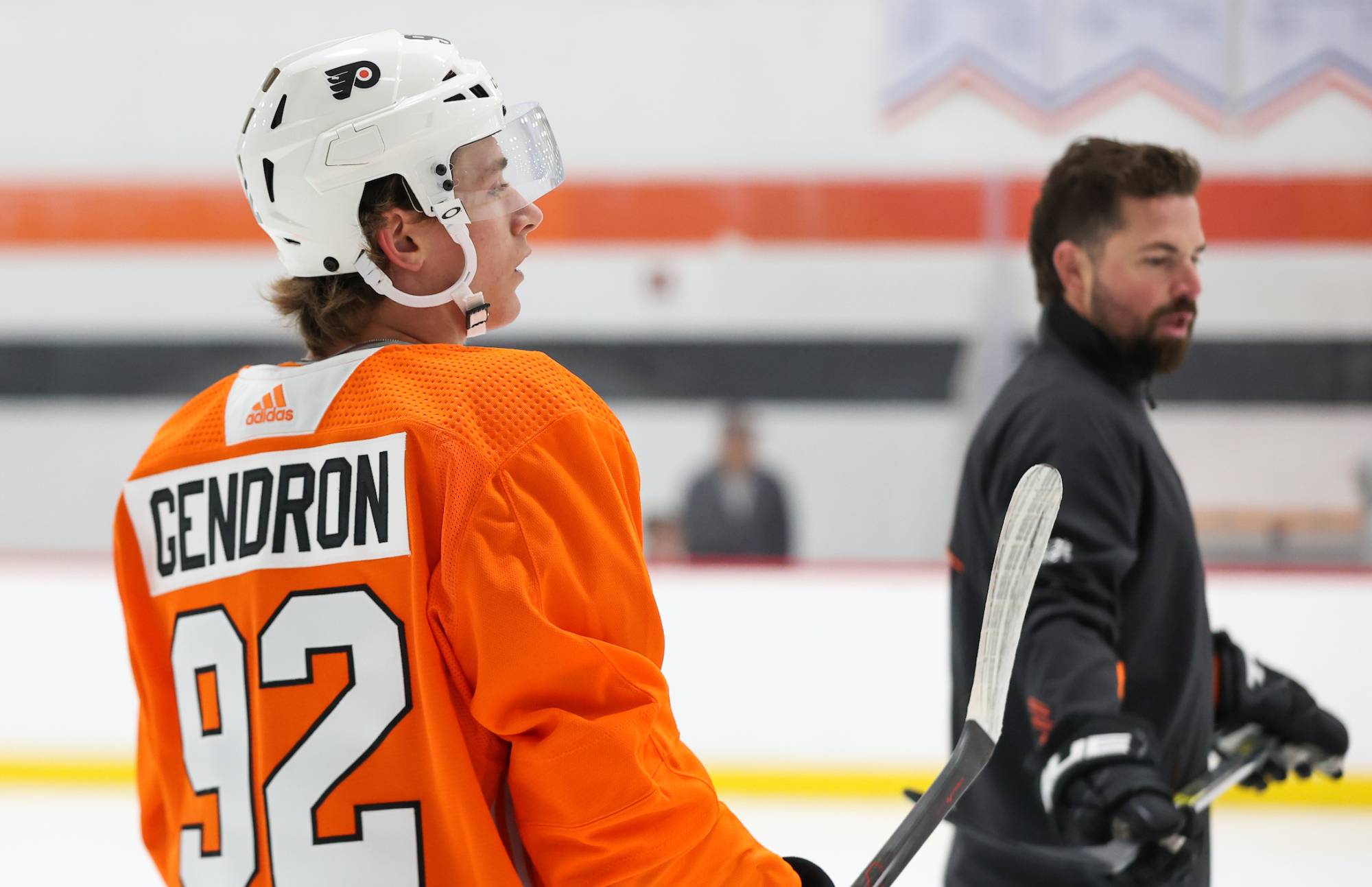Entering the season, it was no secret that the Philadelphia Flyers were not going to be a fantastic 5v5 hockey team. In 2013-14, they were outscored, outshot, and out attempted at 5v5, and they had lost both Kimmo Timonen and Scott Hartnell, two of their better players at even strength.
The hope was that the Flyers’ special teams could carry the team to a playoff berth. After all, the team thrived in both areas in 2013-14, finishing with the league’s eighth-best power play and seventh-best penalty kill.
Philadelphia’s power play has held up their end of the bargain. Led by Claude Giroux, Jakub Voracek and Wayne Simmonds, the Flyers boast the third-best power play in the NHL, with an efficiency rating of 23.6%.
The penalty kill? That’s been a different story entirely.
After finishing in the top ten for two straight seasons, the Flyers currently rank 28th in the NHL in PK efficiency. It’s been a dramatic, shocking fall for a unit that last season combined strong goal prevention with stellar shot prevention.
But things are starting to look up. In recent weeks, the penalty kill has performed much better, and has received corresponding praise in the mainstream media for the turnaround.
 It was supposed to be like this
It was supposed to be like this 
 It was supposed to be like this
It was supposed to be like this 
As reported by the Daily News’ Frank Seravalli on Monday, Craig Berube attributed the improvement to tactics and execution.
“Up ice, we’re getting a lot more pressure. Our guys’ skating deters their breakouts. We’re not letting the other team set up. We did a great job on faceoffs, winning it and coming up the weak side to get the puck down the ice. Little things like that are what make a good penalty kill over the year, when you’re doing all those things.”
Not only are goals against down for the penalty kill, shot attempts are down as well. After a horrid start, the penalty kill has slowly trended back towards their shot prevention rates from last season, as this 10-game rolling average chart shows.
Since mid-November, the Flyers have performed like a middle-of-the-pack shot prevention penalty kill, and recently, they’ve been approaching the level that made Philadelphia so tough to face last season.
So the improvement is real. But it’s not just better execution – the penalty kill has gone through a full-scale optimization since its early struggles.
The Couturier/Read Improvement
Since Mike Richards was traded in the 2011 offseason to break up the Richards-Giroux tandem, the combo of Sean Couturier and Matt Read has been Philadelphia’s most effective and heavily-used duo on the penalty kill.
From the start, their effectiveness was unquestioned, and the stats back that up. From 2011-2014, Read ranks 10th in the NHL among forwards in shorthanded Corsi Against per 60 (total on-ice shot attempts), while Couturier falls right behind him in 12th.
Unfortunately for the Flyers, they looked nothing like that dominant duo to start the season.
For the first month and a half of the season, the vaunted Couturier-Read duo was allowing shorthanded shot attempts at a ridiculously high rate. They weren’t just playing worse than their career averages – they were looking like outright liabilities.
Matt Read in particular was ten kinds of awful in terms of PK shot attempt suppression at the start of the season. And while it’s easy to blame his injury plagued first half for his early struggles, the timeline doesn’t exactly match up.
The worst of Read’s struggles actually predate the injury, which, according to Seravalli, was suffered on November 1st against Florida. In fact, his statistics surprisingly get better post-injury.
Seravalli noted that the high ankle sprain did not stop bothering the Flyers winger until shortly after New Years. Unsurprisingly, that aligns almost perfectly with the start of Read’s recent dramatic improvement in shot suppression.
So what do we make of this timeline? Most likely, the struggles of the Couturier-Read duo at the start of the season were simply not going to last over the long term. The pair had proven over too large of a sample that their true talent at shorthanded shot suppression was far better than their early season performance.
Then, just as things were starting to click, Read got hurt. And while the injury did not halt the overall improvement, the pair still settled in at a performance level measurably worse than their career averages.
With Read now fully healthy and the early season issues far behind both of them, we’re finally getting to see the duo deliver their usual stellar results on the penalty kill.
The Return of the Captain
In 2013-14, Philadelphia’s three most heavily used penalty killers were Braydon Coburn, Sean Couturier and Kimmo Timonen. By the second game of the season, two of those three would be gone from the lineup.
Timonen’s absence was no surprise. Coburn’s foot injury, however, clearly threw the Flyers for a loop, resulting in unexpected increased PK ice time throughout October for players like Nicklas Grossmann, Luke Schenn and Andrew MacDonald.
One player who did not initially see his ice time increased? Claude Giroux.
Before Giroux established himself as one of the league’s true elite centers, he was a mainstay on the penalty kill. In 2010-11, he ranked third among Flyers forwards in PK ice time; in 2011-12, he finished the season fourth.
But as his production increased, his time spent on the penalty kill declined. It made sense – penalty killing is a risky job, and the coaching staff likely wanted to protect Giroux from possible injury by limiting his shorthanded ice time.
There’s only one problem – Claude Giroux is really, really good at killing penalties.
 Claude Giroux is good at hockey
Claude Giroux is good at hockey 
 Claude Giroux is good at hockey
Claude Giroux is good at hockey 
From 2010 through 2014, Giroux ranks third in the entire NHL (among forwards with at least 400 minutes of PK ice time) in terms of on-ice shot attempts against. In addition, he’s first among forwards when looking at shot attempts created. In other words, there’s a strong case to be made that Claude Giroux has been the best penalty killing forward of the decade, at least when looking at shot creation/prevention.
At the start of the season, Giroux was pushed way down the PK depth chart, behind Couturier, Read, Pierre-Edouard Bellemare, R.J. Umberger and Michael Raffl. But after watching his team’s penalty kill flounder in October, Craig Berube made the rational decision – he dramatically ramped up Giroux’s PK minutes.
In October, the captain saw the ice during only 9% of the team’s shorthanded ice time. But in November, that spiked to 23%, and has held steady around 20% since (18% in December, 19% in January).
Berube explained on November 4th that the Flyers’ lack of a righthanded centerman on the PK was another reason Giroux received additional minutes. Last season, Adam Hall took on that role, but with Hall gone, there was a new void and Giroux has been tasked with filling it.
It’s no coincidence that the penalty kill began to slowly improve starting in November. It’s even less of a shock that Giroux leads all Flyers forwards this season in shorthanded shot suppression.
The captain clearly still has it.
New faces stepping up
The re-elevation of Giroux up the depth chart, and the return of Braydon Coburn helped to stabilize the penalty kill a bit during the November and December months. But Giroux’s ice time has basically stayed flat since November, and Coburn missed a large portion of January with yet another injury.
So what explains the most recent surge of effectiveness? It’s been three relatively new faces – Michael Del Zotto, Pierre-Edouard Bellemare and Chris VandeVelde – who have provided a major boost.
Del Zotto’s strong penalty killing at first seems surprising. After all, he has a reputation for inconsistent play in the defensive zone, and as BSH’s Andrew D. pointed out last week, it’s not a baseless criticism.
Yet Del Zotto has been the team’s most effective defenseman this season in terms of PK shot suppression. And maybe it shouldn’t be that surprising – as Scott T. of Pattison Avenue explained in December, Del Zotto was an underrated penalty killer in New York.
After spending much of December in press box jail, Del Zotto was finally paroled and given a spot back on the penalty kill in January, and the result has been nothing but positive. He’s teamed up with Andrew MacDonald to form a solid defensive duo behind Luke Schenn and Nick Schultz.
On the forward side, it’s been an unlikely combination of a 29-year old rookie from France and a castoff from the Edmonton Oilers that has driven the penalty kill’s improvement in January. Pierre-Edouard Bellemare and Chris VandeVelde are quickly establishing themselves as a viable complement to the improved Couturier-Read tandem.
Bellemare has been a part of the PK since the start of the season, though his ice time has spiked dramatically in recent weeks. VandeVelde, on the other hand, went from seeing the ice in only 2% of the team’s shorthanded minutes in December to a whopping 37% in January.
His performance has justified his coach’s faith. VandeVelde trails only Giroux among forwards in PK shot suppression, as the Flyers allow just 90.7 shot attempts per sixty minutes with him on the ice. The Bellemare-VandeVelde emergence has even allowed Berube to do something that seemed unthinkable at the start of the season – limit the PK minutes of Couturier and Read.
In January, Bellemare-VandeVelde actually received more ice time than Couturier-Read. It seems counter-intuitive that the penalty kill would improve in efficiency as the team’s “top” forward combination receives less minutes, but that’s exactly what has happened here.
Now, instead of running Couturier and Read into the ground, Berube is dividing the PK minutes more evenly, and everyone is performing better overall. Credit the coach for recognizing the effectiveness of a newly formed tandem and immediately giving them the ice time that they’ve rightfully earned.
Liabilities seeing limited ice time
The Flyers have given thirteen players at least 40 minutes of shorthanded ice time this season. Here they are, in alphabetical order: Pierre-Edouard Bellemare, Braydon Coburn, Sean Couturier, Michael Del Zotto, Claude Giroux, Nicklas Grossmann, Andrew MacDonald, Michael Raffl, Matt Read, Luke Schenn, Nick Schultz, R.J. Umberger and Chris VandeVelde.
Which two players do you think have been the worst on the team at shorthanded shot prevention? Hint: it’s not a trick question.
If you guessed R.J. Umberger and Nicklas Grossmann, you’re right! Funny how poor even strength play carries over into all facets of the game.
| Player | Shorthanded Corsi Against Per 60 |
| Michael Del Zotto | 87.4 |
| Claude Giroux | 88.4 |
| Nick Schultz | 89.9 |
| Chris VandeVelde | 90.7 |
| Sean Couturier | 92.8 |
| Andrew MacDonald | 95.0 |
| Luke Schenn | 96.1 |
| Matt Read | 96.8 |
| Michael Raffl | 97.6 |
| Braydon Coburn | 101.7 |
| Pierre-Edouard Bellemare | 102.8 |
| R. J. Umberger | 108.1 |
| Nicklas Grossmann | 119.4 |
With players like Del Zotto and VandeVelde seeing their roles increase, there had to be a corresponding decrease in the roles of more established members of the penalty kill. In January, it was Umberger and Grossmann who took the biggest hit.
Umberger’s decrease in PK time seems tied solely to performance. Each month, he’s been used less and less, finally bottoming out in January, when he was used during only 12% of the Flyers’ shorthanded minutes. Grossmann, on the other hand, lost his minutes entirely due to the injury he suffered on January 8 against Washington.
Regardless of the cause, replacing the team’s two worst PK shot preventers with two of their best is a recipe for success. Combine that with the improvement of Couturier and Read and the presence of Giroux and it’s easy to understand why the Philadelphia penalty kill looked so much better in January.
Moving Forward
The improvement of the Flyers penalty kill does not erase its early struggles. Due to their poor start and questionable PK goaltending (particularly Ray Emery’s atrocious 0.793 save percentage while shorthanded), Philadelphia is almost guaranteed to finish in the bottom third of the NHL in PK efficiency, a dramatic drop from recent seasons.
But the gradual improvement does bode well for the future. Players like Matt Read and Sean Couturier did not randomly turn into below-average penalty killers. Claude Giroux is still one of the league’s best. And most importantly, the system employed by the Flyers still seems to work – the coaching staff clearly just needed some time to properly evaluate their new personnel and make the necessary tweaks.
In the short term, it appears that Craig Berube and his assistants are finally rolling a penalty kill that leans on its best performers and limits the minutes of its worst, so it would not be a surprise to see the overall unit continue to perform at a high level through the end of the season.
Of course, the elephant in the room remains Nicklas Grossmann, who has been pushed right back into penalty killing duties since his recent return. Grossmann received the fourth-most PK minutes among Flyers defensemen against Montreal on Tuesday, but that could have been due to Luke Schenn’s late scratching and Braydon Coburn’s continued absence.
As the season has progressed, the Flyers have gotten better at optimizing the penalty kill’s personnel, and the result has been a much more effective shorthanded unit. Here’s to hoping that their blind spot for Nicklas Grossmann doesn’t get in the way of allowing that optimization to continue.

